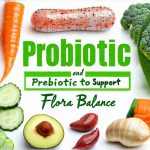The intricate world within our digestive system – often referred to as the gut microbiome – is increasingly recognized as fundamental to overall health. It’s not merely about digestion; this complex ecosystem influences immunity, mental wellbeing, nutrient absorption, and even chronic disease risk. For a long time, we viewed bacteria with suspicion, but now science reveals that many are essential allies, working symbiotically with our bodies. Maintaining a balanced gut microbiome is key, and one effective strategy involves incorporating probiotic-rich foods into our diet. Probiotics are live microorganisms which, when consumed in adequate amounts, confer a health benefit on the host. However, simply taking a probiotic supplement isn’t always the complete answer; cultivating a diverse and thriving gut flora through dietary choices offers a more sustainable approach to long-term digestive wellness.
This article explores how to harness the power of food to support your gut health. We’ll delve into recipes that intentionally incorporate ingredients known for their probiotic content or act as prebiotics – essentially, food for probiotics – promoting a flourishing internal environment. It’s about building a lifestyle around nourishing your microbiome, and enjoying delicious, wholesome meals in the process. Understanding the difference between probiotics and prebiotics is crucial; probiotics are the live beneficial bacteria themselves, while prebiotics are types of fiber that feed these bacteria, allowing them to thrive. Both are vital for optimal gut health, and this article will highlight ways to incorporate both into your daily eating habits. How to balance gut acidity can also play a role in nutrient absorption.
Fermented Foods: The Probiotic Powerhouses
Fermentation is an ancient food preservation technique that not only extends shelf life but also creates probiotic-rich foods. During fermentation, microorganisms like bacteria and yeasts convert carbohydrates (sugars and starches) into organic acids or alcohol. This process naturally introduces beneficial bacteria to the food, making it a potent source of probiotics. Foods like yogurt, kefir, sauerkraut, kimchi, kombucha, miso, and tempeh are all products of this fascinating process – and they’re incredibly versatile in the kitchen. The key is choosing unpasteurized versions whenever possible, as pasteurization kills both harmful and beneficial bacteria. Look for “live and active cultures” on yogurt labels to ensure probiotic content.
Many traditional cuisines have long incorporated fermented foods into their diets, recognizing their health benefits intuitively. For example, Korean kimchi, a spicy fermented cabbage dish, is a staple in Korean cuisine and provides a significant boost of probiotics alongside essential vitamins and minerals. Similarly, German sauerkraut – finely cut cabbage that has been fermented by lactic acid bacteria – offers similar advantages. These foods aren’t just about gut health; they also often boast enhanced digestibility due to the fermentation process breaking down complex carbohydrates. Managing reactions to dairy can also improve digestion.
Incorporating these foods into your diet doesn’t require drastic changes. A dollop of yogurt with breakfast, a side of kimchi with dinner, or a glass of kombucha as a refreshing beverage are all simple ways to increase your probiotic intake. Experimenting with different fermented foods allows you to discover flavors and textures that appeal to your palate while simultaneously supporting your digestive health.
Gut-Friendly Breakfasts: Starting the Day Right
Beginning your day with a gut-friendly breakfast sets the tone for optimal digestion throughout the rest of the day. Here are some ideas:
- Kefir Smoothie: Blend 1 cup kefir (a fermented milk drink, similar to yogurt but thinner), ½ cup berries, 1 tablespoon chia seeds, and a drizzle of honey or maple syrup. Kefir contains a wider range of probiotic strains than many yogurts, making it an excellent choice for gut health.
- Yogurt Parfait: Layer Greek yogurt (choose plain, unsweetened varieties) with granola, berries, and a sprinkle of nuts. Granola adds fiber – a prebiotic – to further support your microbiome.
- Fermented Oatmeal: Add a tablespoon of kefir or yogurt to your oatmeal after it’s cooked. This introduces probiotics without significantly altering the taste.
These breakfasts are quick, easy to prepare, and provide a delicious way to nourish your gut first thing in the morning. Remember to choose organic ingredients whenever possible to minimize exposure to pesticides and herbicides. Furthermore, be mindful of added sugars – opt for natural sweeteners like honey or maple syrup in moderation. Combining warm liquids can also aid digestion.
Lunchtime Boost: Incorporating Fermented Sides & Salads
Lunch can also be an opportunity to incorporate probiotic-rich options. Instead of reaching for processed snacks or sugary drinks, consider these alternatives:
- Kimchi Fried Rice: Add a generous helping of kimchi to your fried rice recipe. The fermentation process not only provides probiotics but also enhances the flavor and texture of the dish.
- Miso Soup with Salad: A small bowl of miso soup alongside a leafy green salad is a light yet satisfying lunch option. Miso, made from fermented soybeans, is packed with beneficial bacteria.
- Sauerkraut & Avocado Sandwich: Add sauerkraut to your favorite sandwich for an unexpected probiotic boost. The tangy flavor complements the richness of avocado perfectly.
These lunchtime options are both nutritious and delicious, offering a practical way to integrate fermented foods into your daily routine. Focus on balance and variety. Don’t rely solely on one type of fermented food – diversifying your intake ensures you’re receiving a wider range of probiotic strains. Avoid trigger foods to help maintain balance.
Dinner Delights: Probiotic-Rich Main Courses & Sides
Dinner is the perfect time to enjoy more substantial probiotic-rich meals. Consider these ideas:
- Tempeh Stir-Fry: Tempeh, made from fermented soybeans, is a fantastic vegetarian protein source and provides a good dose of probiotics. Stir-fry it with your favorite vegetables and a flavorful sauce.
- Fermented Vegetable Side Dish: Serve a side of homemade or store-bought sauerkraut or kimchi with your main course. These add a tangy kick and support digestive health.
- Kombucha-Marinated Chicken/Tofu: Marinate chicken or tofu in kombucha before grilling or baking. The slight acidity of the kombucha tenderizes the protein and adds a subtle flavor.
Don’t be afraid to experiment with different recipes and flavors. The goal is to find ways to incorporate fermented foods into your diet that you genuinely enjoy, making it easier to maintain a healthy gut microbiome over the long term. Remember to listen to your body – if you experience any digestive discomfort after consuming fermented foods, start with small amounts and gradually increase your intake as tolerated. How to rotate foods can also help prevent sensitivities.
Prebiotic Foods: Fueling Your Gut Flora
While probiotics introduce beneficial bacteria into your gut, prebiotics provide the food these bacteria need to thrive. These are typically types of fiber that resist digestion in the upper gastrointestinal tract, reaching the colon where they’re fermented by gut bacteria. This fermentation process produces short-chain fatty acids (SCFAs), which have numerous health benefits, including reducing inflammation and strengthening the gut barrier. Foods rich in prebiotics include garlic, onions, leeks, asparagus, bananas, oats, apples, and chicory root. A diet rich in both probiotics and prebiotics is ideal for optimal gut health.
Prebiotic fiber isn’t absorbed by the body, making it a fantastic way to regulate blood sugar levels and promote feelings of fullness. It also helps improve bowel regularity and supports a diverse microbiome. Unlike probiotics, which are live organisms sensitive to heat and processing, prebiotic fibers are generally more stable during cooking. This means you can incorporate them into your diet without worrying about damaging their beneficial properties.
The synergy between prebiotics and probiotics is known as syn-biotic effect – essentially, they work together to enhance each other’s effectiveness. By feeding the good bacteria in your gut with prebiotic fiber, you are helping them flourish and contribute to a healthier digestive system.
This article provides a starting point for incorporating probiotic-rich foods into your diet. Remember that everyone’s microbiome is unique, so what works best for one person may not work for another. Pay attention to how different foods affect your digestion and adjust your intake accordingly. A diverse and balanced diet, combined with a healthy lifestyle, is the foundation of optimal gut health and overall wellbeing. Daily rituals can also promote regularity.


















